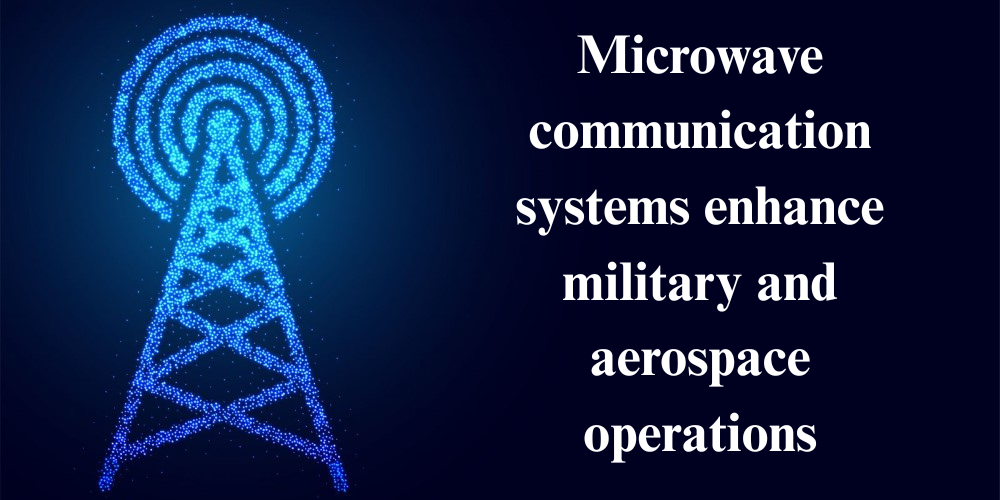Microwave communication systems play a critical role in military and aerospace operations by providing secure, high-speed, and long-range communication across various platforms, including battlefield networks, aircraft, satellites, and space missions. These systems are essential for real-time command and control (C2), surveillance, navigation, and electronic warfare (EW). Below are the key ways in which microwave communication enhances military and aerospace operations.
1. Secure and High-Speed Military Communications
- Microwave systems provide high-bandwidth, real-time communication essential for modern warfare.
- They support encrypted, interference-resistant communications, crucial for military command and control (C2) and battlefield coordination.
- Used in troposcatter communication, where microwaves are scattered in the lower atmosphere, allowing long-range communication without satellites.
Example: AN/TRC-170 Troposcatter System enables U.S. military forces to communicate over 200 miles without satellites.
2. Satellite Communications (SATCOM) for Global Connectivity
- Microwave frequencies (e.g., X-band, Ku-band, and Ka-band) enable secure, high-speed data transmission between military units, aircraft, and naval vessels worldwide.
- Used for real-time intelligence sharing, drone operations, and global military coordination.
- Aerospace applications include spacecraft-to-ground communication and deep-space networks.
Example: MUOS (Mobile User Objective System) is a military SATCOM network using microwave frequencies to provide global secure communications for warfighters.
3. Radar and Surveillance Networks
- Microwave-based radar systems detect, track, and classify enemy aircraft, ships, and missiles.
- Synthetic Aperture Radar (SAR) allows high-resolution imaging for intelligence, surveillance, and reconnaissance (ISR) missions.
- Airborne Warning and Control Systems (AWACS) use microwave radar to monitor large areas for enemy activity.
Example: The E-3 Sentry AWACS aircraft uses microwave radar to detect enemy aircraft hundreds of kilometers away.
4. Electronic Warfare (EW) and Jamming Systems
- Microwave jamming systems disrupt enemy radar, missile guidance, and communication networks.
- Electronic Countermeasures (ECM) use high-power microwave (HPM) pulses to disable enemy electronics.
- Electronic Support Measures (ESM) detect and analyze enemy signals to identify threats.
Example: EA-18G Growler aircraft uses microwave-based jamming pods to disrupt enemy air defense radars.
5. Aircraft and Spacecraft Communication
- Microwave datalinks enable fighter jets, UAVs, and helicopters to exchange battlefield information securely.
- Deep-space communication systems use microwave signals to transmit data from spacecraft to Earth.
- Microwave Landing Systems (MLS) guide aircraft in low-visibility conditions for precision landings.
Example: NASA’s Deep Space Network (DSN) uses X-band and Ka-band microwaves to communicate with spacecraft like the Mars rovers and Voyager probes.
6. Missile Guidance and Precision Targeting
- Microwave signals enable active radar homing for precision-guided missiles.
- Millimeter-wave radar seekers help missiles lock onto and track moving targets.
- Used in laser-guided bomb systems, where microwave communication enables real-time targeting updates.
Example: AMRAAM (Advanced Medium-Range Air-to-Air Missile) uses microwave radar guidance for beyond-visual-range engagements.
7. Hypersonic and Missile Defense Systems
- Microwave tracking radars detect and track hypersonic missiles and ballistic threats.
- High-speed microwave data links enable rapid decision-making in missile defense systems.
- Used in counter-hypersonic weapons to provide real-time guidance.
Example: The THAAD (Terminal High Altitude Area Defense) system relies on microwave X-band radars to intercept incoming missiles.
8. Unmanned Aerial Vehicles (UAVs) and Remote Operations
- Microwave-based telemetry and control systems provide real-time command and video feeds for UAVs.
- Used in drone swarms, where microwave frequencies enable high-speed, low-latency coordination.
- Supports beyond-line-of-sight (BLOS) operations for remote missions.
Example: MQ-9 Reaper drones use Ku-band microwave links for satellite-based remote control and reconnaissance.
9. Battlefield Networking and Tactical Communications
- Microwave-based tactical networks allow military units to communicate across battlefields without relying on external infrastructure.
- Software-Defined Radios (SDR) use microwave frequencies to dynamically adapt to changing battlefield conditions.
- Used in MANET (Mobile Ad Hoc Networks) to provide decentralized, robust military communication.
Example: The WIN-T (Warfighter Information Network-Tactical) system uses microwave radio links for real-time battlefield coordination.
10. Space-Based Microwave Sensors & Remote Sensing
- Microwave radiometers measure Earth’s climate, weather patterns, and military intelligence data.
- Ground-penetrating radar (GPR) detects bunkers, tunnels, and IEDs from aircraft and satellites.
- Used in early warning systems to monitor enemy missile launches.
Example: The SBIRS (Space-Based Infrared System) uses microwave sensors to detect global missile launches.
Conclusion
Microwave communication systems are essential for modern military and aerospace operations, supporting secure communication, radar surveillance, missile defense, electronic warfare, and deep-space exploration. As technology advances, microwave systems will continue to play a vital role in hypersonic weapons, AI-powered defense networks, and next-generation space missions.
Hashtags
#MicrowaveCommunications #MilitaryComms #AerospaceTech #MicrowaveSystems #CommunicationTech #DefenseComms #AerospaceOperations #MilitaryTechnology #SecureCommunication #AerospaceDefense #SatelliteComms #TacticalCommunications #SignalIntegrity #MilitaryNetworking #MicrowaveLinks #RFCommunications #AdvancedNetworking #SpaceComms #ElectronicWarfareTech #NextGenComms #TechInnovation #DefenseTechnology #AerospaceEngineering













